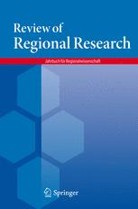
Special Issue of the Review of Regional Research
“The potential of small-scale spatial data“
Review of Regional Research is a section journal of German Speaking section of ERSA and would like to invite contributions for the special issue entitled “The potential of small-scale spatial data’’. Guest editors: Rolf Bergs (PRAC Bergs & Issa Partnership Co.) and Rüdiger Budde (RWI-Leibniz Institute for Economic Research).
A major constraint in spatial analysis has been the information deficit at small-scale spatial level. The use of official area-wide regional data, as provided by Destatis, Eurostat or others, is hampered by the fact that these data, being resolved at NUTS 2 or NUTS 3 level, are too coarse to allow sufficiently precise estimates of certain relationships and impacts or a truly functional classification of space. This has often hampered policy to conclude with targeted interventions into the economy, social affairs, the labour market or the environment.
Since around 2010 the improved provision of small-scale data at neighbourhood level, grid data at one square kilometre resolution or satellite data at a resolution of few hectares has opened doors to stronger empirical precision. Meanwhile, many EU countries grant free access to grid data on population density. In some Nordic countries, further differentiated datasets at grid or small-scale level are available. In Germany, commercial data sets with certain socio-economic contents now supplement official statistics. In addition, there is ubiquitous free access to various sorts of satellite imagery such as e.g. VIIRS (14-bit night satellite images with rich socio-economic and environmental information). Those data processed with novel sophisticated spatial analysis methods, such as supervised or unsupervised spatial clustering or advanced spatial econometrics may largely contribute to evidence-based policy in various fields.
This special issue is intended to contribute to the required knowledge base and to provide new evidence on the advantages of small-scale spatial or grid data. Potential topics include (but are not limited to):
• Generation of small-scale neighbourhood and grid data
• Relevant statistical and econometric methods
• Functional segmentation of space
• Spatial heterogeneity and dependence
• Spatial interaction (e.g. rural-urban)
• Cross-sectional neighbourhood effects (education, health, labour market, investment, environment, living, wealth)
• Policy impact estimated with small-scale spatial data
• Epidemiological research of space
Sumbission can be done via Editorial manager.
Submission deadline: 31 March 2021
Expected publication: August 2022

Stay updated about this event and ERSA upcoming activities, subscribe to ERSA E-newsletter
